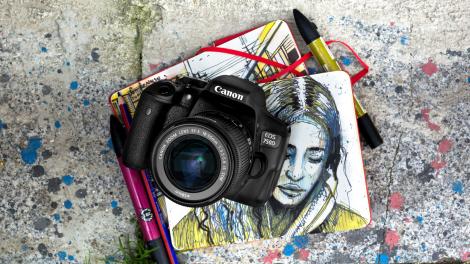
Introduction and specifications
With the introduction of the EOS 760D and 750D as upgrades to the 700D (which is set to continue for the time being), Canon now has five cameras in what it likes to call its beginners’ range. The new 760D and 750D, known as the Rebel T6s and T6i in US territories, sit at the top of this group above the 700D, 100D and 1200D. The 760D is the uppermost model.
In many respects the 750D seems the more logical upgrade to the 700D and it sits immediately under the 760D in the line-up. It is aimed at novices, while the 760D is designed with more experienced photographers in mind, having a few features from cameras higher up in Canon’s DSLR range. Inside, however, the 750D and 760D are near identical and both have the same sensor and processing engine.
This review concentrates on the 750D, but with comparisons to 760D. If you’d like to know more about the slightly more advanced camera, just follow this link to the Canon 760D review.
Read: Canon EOS 760D/T6s review
Specifications
Although they have a slightly different target audience, the 750D and 760D are essentially the same camera as they share many components. They both have Canon’s new 24.2-million-effective pixel APS-C format CMOS sensor, a Digic 6 processing engine and a 19-point phase detection autofocus (AF) system.
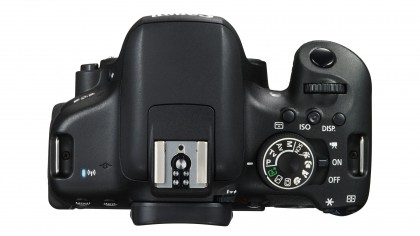
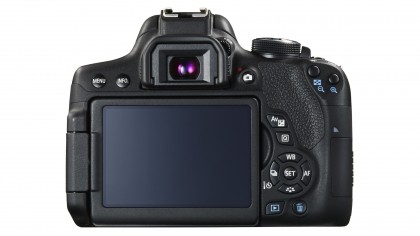
This AF system is available for use when images are composed in the viewfinder rather than when Live View mode is activated and the screen on the back of the camera is used. The choice of AF point can be left to the camera to decide in 19-point AF mode, or it can be set manually in Single point AF or Zone AF mode. In Zone AF mode you have the choice of five groups of points for selection, whereas in Single point mode all 19 points are available for individual selection.
When Live View mode is in use and images or videos are composed on the 750D’s screen, Canon’s new Hybrid CMOS AF III system (with Face detection, Tracking AF, FlexiZone-Multi and FlexiZone-Single modes) is available. This is an improved version of the Hybrid CMOS AF II system found in the Canon 100D, having a greater number of focusing pixels arranged in a more regular array than in the past. Canon says it’s about 4x faster than version II and two generations ahead of the original Hybrid CMOS AF system in the EOS 700D.
Unlike the 760D, the 750D doesn’t have a Servo autofocus option in Live View mode so there isn’t an option for focus to adjust continuously while the shutter release is held down and subject distance changes. There is, however, a Continuous AF option in the Live View section of the main menu. When this is activated focus is adjusted fairly slowly when the shutter release isn’t pressed. It’s designed for use in video mode and to pre-focus when shooting stills.
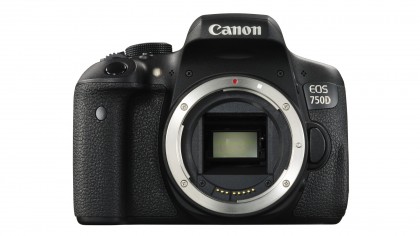
In Tracking AF mode the focus box shifts as the subject moves around the screen, but focus only adjusts when the shutter release button is first half-pressed, you need to lift your finger and press again to readjust.
In a first for Canon DSLRs, both the 750D and 760D feature Wi-Fi and NFC (Near Field Communication) technology to enable them to be connected to a smartphone or tablet for remote control and image sharing. It’s even possible to connect two cameras just by touching the NFC logos together and then transfer images wirelessly.
Despite the step-up from the 18 million pixels in the 700D, the 750D keeps the older sensor’s native sensitivity range of ISO 100-12,800. There’s also an expansion setting of ISO 25,600 for very low light conditions. In movie shooting the maximum native setting is ISO 6,400 and there’s an expansion value of ISO 12,800.
The 750D can also shoot continuously at up to 5fps. This may not seem fantastic by current standards, but it’s still very useful when shooting sport. Plus, the burst depth has been increased from the 30 JPEG or 6 raw files of the 700D to a whopping 940 Large/Fine JPEGs or 8 raw files.
A dedicated 7,560-pixel RGB and Infra Red (IR) sensor is provided for measuring exposure when the viewfinder is in use. As with the 700D’s iFCL metering system, these pixels are grouped into 63 segments (9×7) with the usual options of Evaluative, Centre-weighted, Partial and Spot metering. However, the partial (6.0% of viewfinder) and Spot (3.5% of viewfinder) coverage is a little more precise than in the 700D (9% and 4% respectively) and pixels on the sensor each have their own RGB-IR filter and are read independently. This is a similar system to the one in the excellent 7D Mark II and Canon claims it’s more accurate than the 700D’s with improved colour detection. However, it’s worth remembering that even in Evaluative mode the metering is linked to the AF points, so the brightness of the subject could have an impact upon overall exposure.
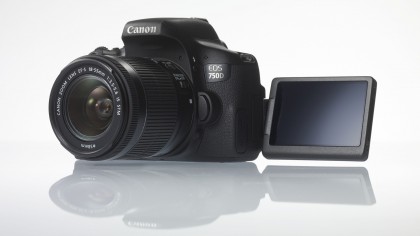
In Live View and video mode the same metering options are available, but the cameras use the imaging sensor to supply the information and Evaluative mode uses 315 zones, Partial metering covers 10% of the scene and Spot 2.7%.
Like the older 700D, the 750D has a 3-inch 1,040,000-dot Clear View II TFT screen that’s touch-sensitive. It also has an aspect ratio of 3:2 to match the uncropped ratio of the imaging sensor.
One feature that 750D lacks in comparison with the 760D is an electronic level. On the 760D this can be displayed on the screen on the back of the camera, or in the viewfinder, to help keep horizons level.
Build and handling
Although it has a different control layout, the 750D feels very similar to the 760D in your hand. It’s not quite as solid as the full frame Canon 5D Mark III (or the same price), but the 750D’s aluminium alloy and polycarbonate resin with glass fibre chassis gives it a pretty durable feel for entry-level DSLR. Reassuringly, it doesn’t creak when it’s gripped tightly.
Textured coatings on the deep grip on the front and the small thum bridge on the back help to make the camera feel comfortable and safe in your grasp.
Anyone with a 700D will find they are on very familiar territory with the 750D as the control layout is almost the same – there are two extra buttons on the top-plate. The 760D, however, is more like the 70D above it in Canon’s DSLR line-up.
The two new buttons on the 750D’s top-plate are the Display button and AF Area selection button, which sit either side of the sensitivity button. Pressing the Display button brings up a non-interactive version of the Quick menu on the rear screen (more about the Quick menu later). Pressing the AF Area selection button once allows the navigation buttons to be used to set the desired AF point. Pressing it multiple times toggles through the AF-point selection modes (Single-point AF, Zone AF and 19-Point automatic selection AF). There’s also an AF point selection button to the right of the thumb rest on the back of the camera, but this doesn’t allow you to toggle through the selection modes. It would be nice to be able to set the AF point on the screen while composing images in the viewfinder as you can with some Panasonic cameras and the Nikon D5500.
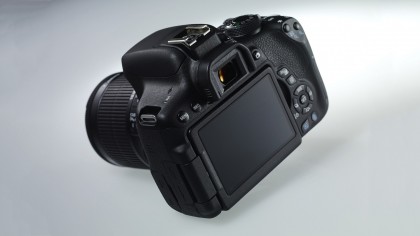
Following the design of other Canon DSLRs, the 750D has a Quick menu that is accessed by pressing the Q button. This gives a quick route to some key features for adjustment. Setting adjustments can be made using the physical buttons and dials or by touching the screen. If you’re not used to using a touch-screen camera you may find that you start out using the buttons and dials, but gradually you start using the touch-screen because it’s so intuitive.
Being a DSLR, the 750D has an optical viewfinder. Canon has used a pentamirror design rather than the pentaprism versions found in more expensive cameras like the 70D. This shows approximately 95% of the scene (the 70D’s covers 98%) so you may need to take care with composition to avoid including unseen elements around the edges of the frame.
As the screen is on an articulating joint it can be seen from a wide range of angles. Reflections are an issue in very bright light, but it is usually possible to see enough detail to compose images. In Live View mode it’s especially helpful to use the screen to set the AF point, or even set the AF point and trip the shutter when composing images at very awkward angles. It’s at these times that you miss the electronic level offered by the 760D, as this would be useful for getting the horizon straight.
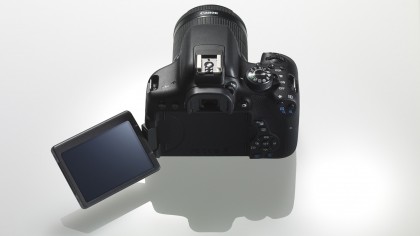
If the screen is on, a half-press of the shutter release or the display button turns it off. This is done automatically by the 760D as it has a sensor just above the viewfinder to detect when the camera is held to your eye.
Arguably the biggest handling difference between the 750D and 760D is that the 760D has a Quick Control dial around the navigation buttons. The 750D relies on an exposure compensation button instead. In manual exposure mode this button needs to be pressed while rotating the dial near the shutter release to set aperture, in the semi automatic modes it’s used with the dial to adjust exposure compensation. It’s a quick and easy task, but the Quick Control dial on the 760D makes these adjustments a little faster.
The exposure mode is set using the dedicated dial on the right of the 750D’s top-plate – this is on the left on the 760D. Unlike the 760D there’s no lock on the dial, but it doesn’t get knocked out of position easily and it provides a route to the same same exposure modes including program, shutter priority, aperture priority and manual as well as options such as Full Automatic (Scene Intelligent Auto), Creative Auto (which allows you to take control with simple instructions using non-photographic terms) and a collection of user-selectable scene modes, including some within Special Scene (SCN) mode.
As mentioned earlier, the 760D and 750D both have Wi-Fi and NFC (near field communication) technology and these are activated via the menu as there’s no dedicated button. I found it easy to connect the 750D to another NFC-enabled device. This could be useful when the Canon Connect Station CS100 becomes available as it should make wireless image transfer and storage simple.
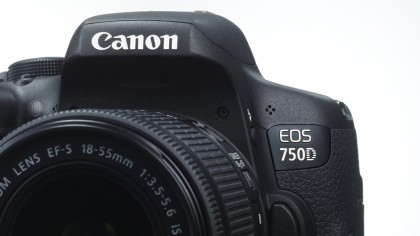
It’s also straightforward to connect the 750D to a non-NFC smartphone like an iPhone, although there’s no helpful QR code display so you have to enter the password the first time you make a connection. Once connected, Canon’s free Camera Connect app can be used to download images or control the camera remotely. In remote control mode the phone can be used to adjust exposure (shutter speed, aperture and sensitivity) and the set the autofocus point and trip the shutter.
As the 750D doesn’t have a secondary LCD screen like the 760D, there’s a dedicated light that illuminates to show when the Wi-Fi system is active.
Performance
As they have the same sensor and processing engine it seemed very likely that the 750D and 760D would produce the same image quality and, not surprisingly, or tests have confirmed that they do. We saw an occasional exposure variation, but this can be explained easily by slight differences in the composition (resulting from the different lens position) and/or the location of the active AF point. We found that the two cameras produce the same colours, capture the same level of detaiI and control noise in the same way.
The 750D, 760D and EOS M3 all use Canon’s first 24-million pixel sensor, so naturally everyone is keen to find out how much detail they can resolve. Well it’s good news – the level of detail in images is a huge leap up from that from the 700D, but noise levels are about the same despite the extra 6 million pixels on the sensor.
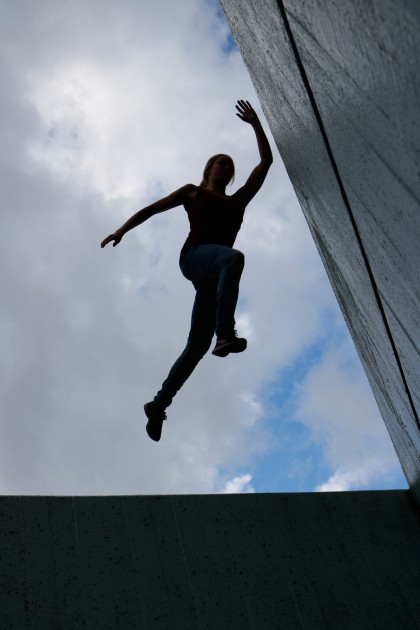
Click here for a full size version.

Click here for a full size version.
Interestingly, our lab tests reveal that the 20Mp 7D Mark II can match Canon’s new 24Mp cameras for detail resolution at the low to mid sensitivity settings, and beat them at higher settings. The most likely explanation for this, apart from the different design of the sensor, is that the dual Digic 6 processors in Canon’s top-end APS-C format camera enables it to run more advanced noise reduction algorithms. After all, the 7D Mark II has a higher maximum sensitivity setting than the 750D of ISO 16,000 in the native range and a ISO 51,600 expansion setting.
Viewed at 100% on-screen, the 750D’s high sensitivity JPEGs look softer than simultaneously captured raw files, but even at ISO 12,800 some look good at around A3 size (16 x 12inches). The ball of red wool in the brighter side of the ISO 12,800 JPEG images of our sensitivity test scene, for example, lacked detail and looked like a bright amorphous blob at A3 size. The raw file is much better.
As usual, when all noise reduction is turned off the raw files have more visible noise at 100%, but it’s fine grained and there’s no banding, so it’s possible to produce images that have a bit more ‘bite’ than the JPEGs.
Chroma noise only really becomes obvious at 100% in raw files captured at ISO 1600 and above (when all noise reduction is turned off). Meanwhile the softening of detail that tends to go hand-in-hand with noise reduction in the default settings becomes apparent at 100% in JPEGs captured at ISO 3200, though it’s not really an issue until ISO 12,800.
When using Live View mode I found the 750D is capable of getting subjects sharp quickly, so it’s possible to compose images on the main screen when hand-holding the camera. However, it’s not really fast enough to use it to shoot moving subjects, and there’s no servo option, so it can’t adjust focus as subject distance changes when your finger is on the shutter release.

Click here for a full size version.

Click here for a full size version.

Click here for a full size version.
The phase detection AF system that’s available when composing images in the viewfinder is fast and accurate, even in quite low light with the kit lens mounted. It means it’s a much better choice when shooting sport or action. In 19-point mode it does a pretty good job of identifying the subject, but Zone-AF and Single-point mode are a better choice provided you can keep the active area over the right part of the scene.
Canon’s new metering system in the 750D is also very good, even managing to produce good results in conditions that are traditionally very challenging. As with the 700D’s iFCL metering system, exposure is weighted towards the subject under the active AF point, but it seems to do a better job of producing a balanced exposure in high contrast situations. The compensation control is still required occasionally, but only in situations where you’d expect to need it.
Lab tests: resolution
We’ve carried out lab tests on the Canon EOS 760D across its full ISO range for resolution, noise (including signal to noise ratio) and dynamic range. We test the JPEGs shot by the camera, but we also check the performance with raw files. Most enthusiasts and pros prefer to shoot raw, and the results can often be quite different.
We’ve also picked out three of its chief rivals so that you can compare their performance directly.
• Canon EOS 700D: Until the launch of the 750D and 760D the 700D was Canon’s top beginner’s DSLR. So how does its older 18-megapixel sensor compare with the 24-megapixel sensor in the 760D?
• Nikon D5500: The first Nikon SLR to have a touchscreen, this 24-megapixel model has no AA filter over the sensor for better detail resolution than the 760D/750D.
• Pentax K-S2: This 20-megapixel DSLR is weatherproof so you can use it even if it starts to rain. There’s also a variangle screen (not touch-sensitive) and WiFi connectivity for sharing images.
Canon EOS 760D resolution charts
We test camera resolution using an industry-standard ISO test chart that allows precise visual comparisons. This gives us numerical values for resolution in line widths/picture height, and you can see how the 760D compares with its rivals in the charts below.
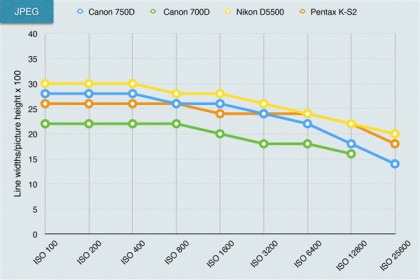
JPEG resolution analysis: While it can’t quite match the Nikon D5500 for detail resolution, the 750D captures significantly more detail than the 700D. The D5500 is probably helped in this respect because it doesn’t have an optical low pass filter over the sensor, whereas the 750D does.
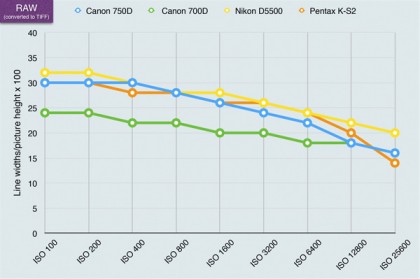
Raw (converted to TIFF) resolution analysis: Apart from at the highest sensitivity setting, where a lower pixel count helps with noise control, the 750D captures significantly more detail than the 700D. Again it comes close to, but doesn’t quite match the D5500. The Pentax K-S2 performs well considering its filterless sensor has ‘just’ 20 million pixels.
Sample resolution results
This is the chart we use for testing camera resolution. The key area is just to the right of centre, where a series of converging lines indicates the point at which the camera can no longer resolve them individually. We shoot this chart at all of the camera’s ISO settings, and here are two samples at ISO 100 and ISO 6400.

ISO 100: Click here for a full size version.
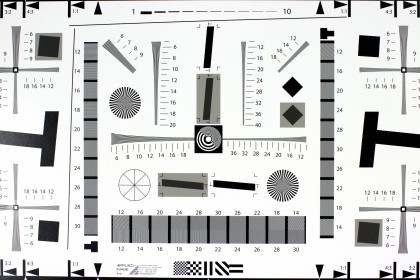
ISO 6400: Click here for a full size version.
Lab tests: dynamic range
Dynamic range is a measure of the range of tones the sensor can capture. Cameras with low dynamic range will often show ‘blown’ highlights or blocked-in shadows. This test is carried out in controlled conditions using DxO hardware and analysis tools.
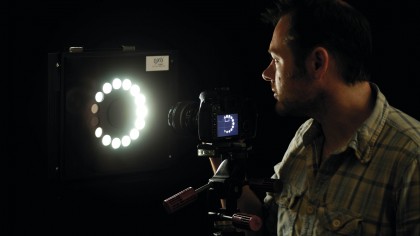
Read: Noise and dynamic range results explained
Dynamic range is measured in exposure values (EV). The higher the number the wider the range of brightness levels the camera can capture. This falls off with increasing ISO settings because the camera is having to amplify a weaker signal. Raw files capture a higher dynamic range because the image data is unprocessed.
Canon EOS 750D dynamic range charts
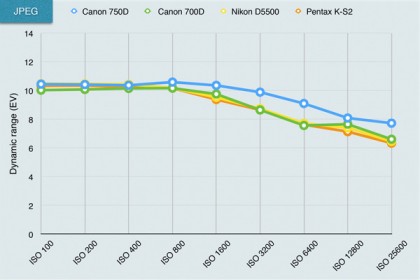
JPEG dynamic range analysis: The 750D has good, but not competition-beating dynamic range until sensitivity reaches around ISO 800. The 750D captures a wider range of tones than the other cameras at higher sensitivities.

Raw (converted to TIFF) analysis: The 750D and 760D capture a wide range of tones, especially at sensitivities below ISO 800. They are about 0.5EV better than the 700D at the highest sensitivity settings. However, they can’t quite match the Pentax K-S2 which captures the widest spread of tones.
Lab tests: signal to noise ratio
This is a test of the camera’s noise levels. The higher the signal to noise ratio, the greater the difference in strength between the real image data and random background noise, so the ‘cleaner’ the image will look. The higher the signal to noise ratio, the better.
Canon EOS 750D signal to noise ratio charts
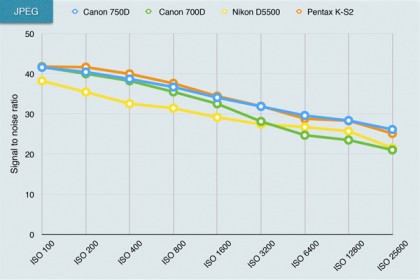
JPEG signal to noise ratio analysis: Like the 760D, the 750D’s signal to noise ratio is similar or slightly better than the 700D’s. This indicates that the images have a similar level of noise despite the increase in pixel count and detail resolution.
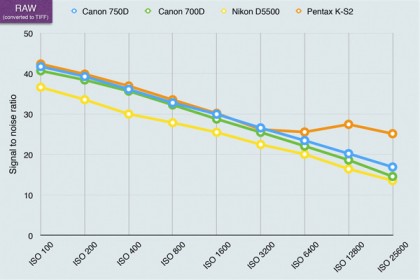
Raw (converted to TIFF) dynamic range analysis: The 750D, puts in a good performance with a signal to noise ratio that beats the Nikon D5500 indicating that it produces slightly cleaner images.
Sample ISO test results
The signal to noise ratio charts use laboratory test equipment, but we also shoot a real-world scene to get a visual indication of the camera’s noise levels across the ISO range. The right side of the scene is darkened deliberately because this makes noise more obvious.

ISO 100: Click here for a full size version.
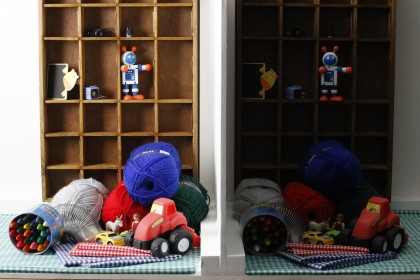
ISO 6400: Click here for a full size version.
Verdict
Like the 760D immediately above it in Canon’s SLR line-up, the 750D has a 24-million pixel CMOS sensor that’s likely to appear in future Canon cameras. This produces high quality photographs that have a nice balance of image size and file size as well as image detail and noise visibility.
The 750D is designed to appeal to less experienced photographers than the 760D is intended to attract. It lacks the secondary LCD screen on the top-plate, the Quick Control dial around the navigation buttons and the electronic level display. Dedicated Live View shooters may also miss the Servo autofocusing of the 760D.
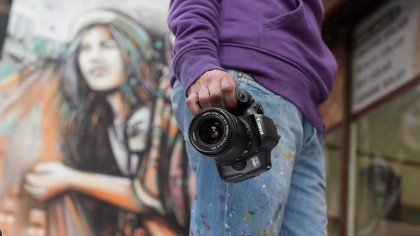
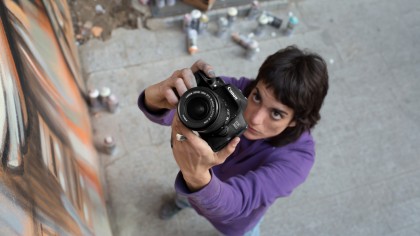
As the 750D has a vari-angle screen which allows key settings to be seen from a range of angles, I don’t think the secondary screen is a major loss. However, I miss the ability to adjust exposure compensation by just rotating the Quick Control dial (rather than pressing the Aperture/Exposure compensation button while rotating the Main dial) and the level’s reassurance that the horizon won’t be wonky. I think these aspects make the extra cost of the 760D worthwhile. The handling of the 760D is unlikely to baffle novice photographers any more than the 750D’s.
We like
Like the 760D, the 750D is very comfortable to hold and use. All the controls are within easy reach and the touch-control is very well implemented, allowing you to navigate the menus and make setting selections with you a few taps. It’s also very handy to be able to pinch-zoom into images to check sharpness. I particularly like having a vari-angle screen because it makes it easy to compose images at awkward angles and encourages you to be creative. It’s also helpful to be able to set the AF point and/or trip the shutter with a tap on the screen.
We dislike
Being an SLR, the 750D has an optical viewfinder. This is a decent unit, and many photographers still prefer optical viewfinders, but it has the disadvantage of not being able to show the impact of setting changes. The image in the viewfinder stays the same when exposure, white balance or Picture Style are adjusted. This means that the appearance of the captured image can come as a bit of a surprise to inexperienced photographers who are learning about setting exposure and the like. This is a characteristic of DSLR design in general, though, not the 750D in particular.
As a vari-angle screen encourages users to shoot from different angles it would be handy to have an electronic level to make it easier to ensure that the horizon is straight.
It’s also worth pointing out here that because the viewfinder only covers 95% of the scene, you need to watch out for things being included in the images that you can’t see in the viewfinder.
Verdict
The Canon 750D (and 760D) is capable of capturing far more detail than the 700D and noise is controlled well throughout the native sensitivity range, even at the top native setting. Colours are also generally very good straight from the camera and the white balance system can generally be relied upon to produce a decent result in its automatic setting. In addition, the touch-screen is detail-rich (in all but very bright light) and is very responsive. Plus, the Live View autofocus system is good enough to allow hand-holding of the camera with stationary or slow subjects. All this, combined with excellent phase detection autofocus and metering systems, adds up to a very nice camera.
![]()
Related Posts
December 6, 2021
7+ Web Design Trends for 2022: Which Will You Use?
December 6, 2021
The 10 Best WordPress Booking Plugins to Use On Your Website
December 6, 2021
How to Use a Web Cache Viewer to View a Cached Page
November 6, 2021
10 Modern Web Design Trends for 2022
November 6, 2021
Best Free SSL Certificate Providers (+ How to Get Started)
November 6, 2021
How to Design a Landing Page That Sends Conversions Skyrocketing
November 6, 2021
What Are the Best WordPress Security Plugins for your Website?
October 6, 2021
Your Guide to How to Buy a Domain Name
October 6, 2021
How to Build a WordPress Website: 9 Steps to Build Your Site
September 6, 2021
10 Best Websites for Downloading Free PSD Files
September 6, 2021
HTML5 Template: A Basic Code Template to Start Your Next Project
September 6, 2021
How Much Does It Cost to Build a Website for a Small Business?
September 6, 2021
A List of Free Public CDNs for Web Developers
September 6, 2021
6 Advanced JavaScript Concepts You Should Know
August 6, 2021
10 Simple Tips for Launching a Website
August 6, 2021
25 Beautiful Examples of “Coming Soon” Pages
August 6, 2021
10 Useful Responsive Design Testing Tools
August 6, 2021
Best-Converting Shopify Themes: 4 Best Shopify Themes
July 6, 2021
What Is Alt Text and Why Should You Use It?
July 6, 2021
24 Must-Know Graphic Design Terms
June 6, 2021
How to Design a Product Page: 6 Pro Design Tips
April 6, 2021
A Beginner’s Guide to Competitor Website Analysis
April 6, 2021
6 BigCommerce Design Tips For Big Ecommerce Results
April 6, 2021
Is WordPress Good for Ecommerce? [Pros and Cons]
March 6, 2021
Make Websites Mobile-Friendly: 5 Astounding Tips
March 6, 2021
Shopify vs. Magento: Which Platform Should I Use?
March 6, 2021
Top 5 Web Design Tools & Software Applications
February 6, 2021
Website Optimization Checklist: Your Go-To Guide to SEO
February 6, 2021
5 UX Design Trends to Dazzle Users in 2021
February 6, 2021
What Is the Average Page Load Time and How Can You Do Better?
February 6, 2021
Choosing an Ecommerce Platform That Will Wow Customers
February 6, 2021
7 Best Practices for Crafting Landing Pages with Forms
February 6, 2021
7 B2B Web Design Tips to Craft an Eye-Catching Website
January 6, 2021
Mobile-Friendly Checker | Check Your Site’s Mobile Score Now
January 6, 2021
8 Tips for Developing a Fantastic Mobile-Friendly Website
December 6, 2020
How to Add an Online Store to Your Website [4 Ways]
December 6, 2020
5 UX Design Tips for Seamless Online Shopping
November 6, 2020
Ecommerce Website Essentials: Does Your Site Have All 11?
November 6, 2020
5 Small Business Website Essentials You Need for Your Site
November 6, 2020
Your Website Redesign Checklist for 2020: 7 Steps for Success
May 1, 2020
Psychology of Color [Infographic]
April 21, 2020
How to start an online store that drives huge sales
January 3, 2020
5 Lead Generation Website Design Best Practices
March 6, 2019
6 Reasons You Should Redesign Your Website in 2019
March 6, 2019
7 Web Design Trends for 2019
February 19, 2019
Who owns the website/app source code, client or developer
February 7, 2019
Don’t Let Your Domain Names Expire in 2019
January 8, 2019
2019 Website Development Trends To Note
October 6, 2017
How Web Design Impacts Content Marketing
October 6, 2017
How to Choose a Navigation Setup
August 6, 2017
Why User Experience Matters to Marketing
July 6, 2017
5 Ways Web Design Impacts Customer Experience
September 6, 2016
How to Learn Angular
September 6, 2016
The Excuses for Not Having a Website (Infographic)
September 6, 2016
How to Build an Award-Winning Web Design Team
September 6, 2016
13 Free Data Visualization Tools
August 6, 2016
How Selling Pastries Helped Us Design a Better Product
August 6, 2016
11 Sites to Help You Find Material Design Inspiration
July 4, 2016
How to change free wordpress.com url
April 6, 2016
The 5 Best Free FTP Clients
April 6, 2016
7 Free UX E-Books Worth Reading
March 6, 2016
Can Handwritten Letters Get You More Clients?
December 10, 2015
Star Wars Week: How to create your own Star Wars effects for free
December 6, 2015
20 "Coming Soon" Pages for Inspiration
December 6, 2015
6 Free Tools for Creating Your Own Icon Font
December 6, 2015
9 Useful Tools for Creating Material Design Color Palettes
November 6, 2015
20 Free UI Kits to Download
November 6, 2015
50 Web Designs with Awesome Typography
November 6, 2015
When to Use rel="nofollow"
November 6, 2015
7 Free Books That Will Help You Become More Productive
November 6, 2015
50 Beautiful One-Page Websites for Inspiration
November 6, 2015
Circular Images with CSS
October 6, 2015
Lessons Learned from an Unsuccessful Kickstarter
October 6, 2015
5 Games That Teach You How to Code
October 6, 2015
Cheatsheet: Photoshop Keyboard Shortcuts
October 6, 2015
An Easy Way to Create a Freelance Contract for Your Projects
October 6, 2015
50 Design Agency Websites for Inspiration
September 29, 2015
JB Hi-Fi shutting the book on ebooks
September 24, 2015
Opinion: Quick, Quickflix: It's time to give yourself the flick
September 24, 2015
New Star Wars 360-degree video is among first on Facebook
September 21, 2015
Apple purges malicious iPhone and iPad apps from App Store
September 12, 2015
Apple's new Live Photos feature will eat up your storage
September 12, 2015
The latest Windows 10 Mobile preview has been delayed
September 12, 2015
IBM buys StrongLoop to add Node.js development to its cloud
September 8, 2015
Fake Android porn app takes your photo, then holds it ransom
September 6, 2015
50 Restaurant Websites for Inspiration
September 6, 2015
Zero UI — The Future of Interfaces
September 6, 2015
50 Beautiful Websites with Big Background Images
September 6, 2015
Infographic: 69 Web Design Tips
September 6, 2015
Free Windows 10 Icons
September 2, 2015
Instagram turns itself into a genuine messaging service
August 11, 2015
In Depth: How Microsoft taught Cortana to be more human
August 11, 2015
Windows 10 price, news and features
August 11, 2015
Windows 10's broken update introduces endless reboot loop
August 11, 2015
Windows 10 races to 27m installs
August 11, 2015
Windows 10 IoT Core gets first public release
August 10, 2015
iOS Tips: How to backup iPhone to an external drive
August 10, 2015
Windows 8.1 RT finally getting Windows 10 Start Menu
August 10, 2015
How to use Windows Hello
August 10, 2015
Review: Moto Surround
August 10, 2015
Review: Moto G (2015)
August 9, 2015
8 of the best free VPN services
August 8, 2015
Use Firefox? Mozilla urges you update ASAP
August 7, 2015
Mac Tips: Apple Mail: How to remove the Favorites Bar
August 7, 2015
How to make the OS X dock appear faster
August 7, 2015
Review: BQ Aquaris E45 Ubuntu Edition
August 7, 2015
Review: Acer Liquid Jade Z
August 6, 2015
How to reinstall Linux
August 6, 2015
How to reinstall Windows
August 6, 2015
Updated: Apple Music: release date, price and features
August 6, 2015
Social News Websites for Front-End Developers
August 6, 2015
10 Free JavaScript Books
August 6, 2015
50 Beautiful Blog Designs
August 6, 2015
Animated SVG Pipes Effect
August 6, 2015
Launching Your First App
August 5, 2015
Windows 10 goes freemium with paid apps
August 5, 2015
Updated: Week 1 with Windows 10
August 5, 2015
Mac Tips: How to manage Safari notifications on Mac
August 5, 2015
Microsoft Sway may kill the PowerPoint presentation
August 4, 2015
Microsoft gives Outlook on the web a new look
August 4, 2015
Mac OS X vulnerable to new zero-day attack
August 4, 2015
Windows 10 users warned of two scams
August 4, 2015
Microsoft's Docs.com is now available to everyone
August 3, 2015
Mac Tips: How to edit the Favorites sidebar on Mac
August 3, 2015
Updated: Windows 10 price, news and features
July 29, 2015
Review: HP ProDesk 405 G2
July 29, 2015
Hands-on review: HP Elite x2 1011
July 29, 2015
Hands-on review: Updated: Windows 10 Mobile
July 29, 2015
Review: Updated: Nvidia Shield Android TV
July 28, 2015
LIVE: Windows 10 launch: Live Blog!
July 28, 2015
How to prepare for your upgrade to Windows 10
July 28, 2015
Review: Updated: Windows 10
July 28, 2015
Review: Updated: HP Pro Tablet 608
July 28, 2015
Review: Heat Genius
July 28, 2015
Hands-on review: Moto X Play
July 28, 2015
Hands-on review: Moto X Style
July 28, 2015
Hands-on review: Moto G (2015)
July 28, 2015
Review: 13-inch MacBook Air (early 2015)
July 28, 2015
Hands-on review: OnePlus 2
July 28, 2015
Review: LG 65EG960T 4K OLED
July 28, 2015
Mac Tips: How to share printers on Mac
July 27, 2015
Apple Music's arrival hasn't opened Pandora's box
July 26, 2015
Review: Garmin Swim
July 25, 2015
How to merge OS X contacts into an existing list
July 25, 2015
Hands-on review: UPDATED: ZTE Axon
July 24, 2015
Mac Tips: How to zoom in on a Mac
July 24, 2015
What Windows 10 means for the enterprise
July 24, 2015
Review: JBL Charge 2 Plus
July 24, 2015
Review: Acer Aspire S7
July 24, 2015
Review: Updated: Canon G3 X
July 24, 2015
Review: Updated: iPad Air 2
July 24, 2015
Review: Thinksound On1
July 24, 2015
Review: Asus Chromebook Flip
July 24, 2015
Review: Garmin Forerunner 225
July 23, 2015
Review: Garmin nuvi 68LM
July 23, 2015
Review: Samsung Galaxy S6 Active
July 23, 2015
Review: Bowers and Wilkins P5 Wireless
July 23, 2015
Review: Dell XPS 15 (2015)
July 21, 2015
Review: Fuji S9900W
July 21, 2015
Review: Updated: Fitbit Surge
July 21, 2015
Review: UE Roll
July 21, 2015
Hands-on review: Ubik Uno
July 20, 2015
Review: Samsung HW-J650
July 20, 2015
Updated: 40 best Android Wear smartwatch apps 2015
July 20, 2015
Review: Acer Chromebook C740 review
July 20, 2015
Review: Huawei Talkband B2
July 20, 2015
Review: Dell Venue 10 7000
July 20, 2015
Review: Intel Core i7-5775C
July 17, 2015
Mac Tips: How to delete locked files on Mac
July 17, 2015
Review: Pebble Time
July 16, 2015
Microsoft just made Windows XP even less secure
July 16, 2015
Windows 8.1 RT is getting an update this September
July 16, 2015
OS showdown: Windows 10 vs Windows 8.1 vs Windows 7
July 16, 2015
Review: Acer CB280HK
July 15, 2015
Windows 10 is ready for new laptops and PCs
July 15, 2015
Explained: How to take a screenshot in Windows
July 15, 2015
Office for Windows 10 appears in latest build
July 14, 2015
Review: ZTE Axon
July 14, 2015
Review: ViewSonic VP2780-4K
July 14, 2015
Hands-on review: SanDisk Connect Wireless Stick
July 14, 2015
Review: Oppo PM-3
July 14, 2015
Review: BT 11ac Dual-Band Wi-Fi Extender 1200
July 14, 2015
Review: Fuji X-T10
July 13, 2015
How to build an SEO strategy for your business
July 13, 2015
Review: Lenovo ThinkPad Yoga 15
July 13, 2015
Review: Audio-Technica ATH-MSR7
July 13, 2015
Review: Garmin NuviCam LMT-D
July 13, 2015
Review: Dell Inspiron 13 7000
July 13, 2015
Hands-on review: AstroPi SenseHAT
July 13, 2015
Hands-on review: EE Rook
July 13, 2015
Hands-on review: Updated: HTC Vive
July 12, 2015
Here's the ultimate software list for PC fanatics
July 10, 2015
How to use the new Photos app for Mac
July 10, 2015
Windows 10 Insider Preview Build 10166 available now
July 10, 2015
Splunk spends big on cybersecurity acquisition
July 10, 2015
Making Windows 10 apps just got a whole lot easier
July 10, 2015
Review: Lenovo LaVie Z 360
July 9, 2015
OS X El Capitan public beta available right now
July 9, 2015
Microsoft finally unveils Office 2016 for Mac
July 9, 2015
Review: Updated: Chromecast
July 9, 2015
Review: Updated: Tesco Hudl 2
July 9, 2015
Review: Lenovo ThinkPad E550
July 9, 2015
Review: Updated: Google Nexus 6
July 8, 2015
What you need to know about Windows Server 2016
July 7, 2015
Microsoft to hike enterprise cloud pricing
July 6, 2015
Hacking Team end up being totally 0wned
July 6, 2015
Review: HP Pro Slate 12
July 6, 2015
Review: Samsung 850 Pro 2TB
July 6, 2015
Review: Asus RT-AC87U
July 6, 2015
Review: Jawbone UP2
July 6, 2015
Reimagining the Web Design Process
July 6, 2015
50 Clean Websites for Inspiration
July 6, 2015
15 Free Books for People Who Code
July 6, 2015
Web Storage: A Primer
July 6, 2015
A Look at Some CSS Methodologies
July 3, 2015
6 Essential Mac Mouse and Trackpad Tips
July 2, 2015
How to install a third party keyboard on Android
July 2, 2015
Review: UPDATED: Asus Zenfone 2
July 2, 2015
Review: Alienware 13
July 2, 2015
Review: HP DeskJet 1010
July 1, 2015
5 issues we want Apple Music to fix
June 13, 2015
Cortana will get its own button on Windows 10 PCs
June 12, 2015
Windows 10 will come with universal Skype app
June 12, 2015
iPad music production: 18 Best apps and gear
June 12, 2015
Windows 10 all set for early enterprise struggle
June 12, 2015
Review: Garmin VIRB Elite
June 11, 2015
Review: Updated: Nvidia Shield Tablet
June 11, 2015
Review: Nokia Lumia 635
June 10, 2015
Microsoft brings more online tweaks to Office 365
June 10, 2015
Mac Tips: How to use Screen Sharing in Mac OS X
June 9, 2015
Hands-on review: Meizu M2 Note
June 9, 2015
Hands-on review: EE 4GEE Action Camera
June 9, 2015
Review: Toshiba 3TB Canvio external hard drive
June 9, 2015
Review: Olympus SH-2
June 8, 2015
Hands-on review: Updated: Apple CarPlay
June 8, 2015
UPDATED: iOS 9 release date, features and news
June 8, 2015
Review: Updated: Roku 2
June 8, 2015
Review: Updated: PlayStation Vue
June 8, 2015
Review: Dell PowerEdge R730
June 8, 2015
Review: Canon SX710 HS
June 7, 2015
UPDATED: iOS 9 release date, features and rumors
June 7, 2015
Review: Lenovo S20-30
June 6, 2015
Free Writing Icons
June 6, 2015
15 CSS Questions to Test Your Knowledge
June 6, 2015
The Best CSS Reset Stylesheets
June 6, 2015
How CSS Specificity Works
June 5, 2015
'Delay' is a new feature in Windows 10
June 5, 2015
Review: Beyerdynamic Custom One Pro Plus
June 5, 2015
Latest SEO Marketing tools
June 5, 2015
Review: Nvidia Shield Android TV
June 5, 2015
Review: Honor 4X
June 5, 2015
Review: In Depth: Oppo R5
June 3, 2015
Hands-on review: Huawei P8 Lite
June 3, 2015
How To: How to create eBooks on a Mac
June 3, 2015
Review: Updated: Tidal
June 2, 2015
Review: Updated: Asus ZenWatch
June 2, 2015
Review: Alcatel OneTouch Idol 3
June 2, 2015
Review: Updated: Nokia Lumia 1520
June 2, 2015
Review: Updated: Yotaphone 2
June 2, 2015
Review: Updated: Nokia Lumia 625
June 2, 2015
Review: Creative Muvo Mini
June 1, 2015
Review: Acer TravelMate P645 (2015)
June 1, 2015
Hands-on review: Corsair Bulldog
May 29, 2015
In Depth: NetApp: a requiem
May 29, 2015
July is looking definite for Windows 10 release
May 29, 2015
Hands-on review: Google Photos
May 28, 2015
Mac Tips: The 16 best free GarageBand plugins
May 28, 2015
Review: Canon 760D (Rebel T6s)
May 27, 2015
Review: Lenovo Yoga 3 14
May 27, 2015
Hands-on review: Serif Affinity Photo
May 27, 2015
Review: Garmin Vivoactive
May 26, 2015
Review: Datacolor Spyder5 Elite
May 26, 2015
Hands-on review: Sony Xperia Z3+
May 26, 2015
Review: Epson BrightLink Pro 1410Wi
May 26, 2015
Review: Technics Premium C700
May 26, 2015
Review: Canon EOS M3
May 26, 2015
Review: Updated: HTC One M9
May 26, 2015
Review: Updated: Sony Xperia Z3 Compact
May 25, 2015
Review: Updated: New Nintendo 3DS
May 25, 2015
Updated: 50 best Mac tips, tricks and timesavers
May 25, 2015
Updated: Windows email: 5 best free clients
May 25, 2015
Instagram is planning to invade your inbox
May 25, 2015
Review: Updated: Foxtel Play
May 24, 2015
How Windows 10 will change smartphones forever
May 24, 2015
Review: Vodafone Smart Prime 6
May 24, 2015
Review: Updated: iPad mini
May 22, 2015
Office Now may be Cortana for your work life
May 22, 2015
Review: Updated: Lenovo Yoga 3 Pro
May 22, 2015
Review: Microsoft Lumia 640 LTE
May 22, 2015
Review: Updated: Fitbit Flex
May 21, 2015
Updated: Best free Android apps 2015
May 21, 2015
Review: Asus ZenBook Pro UX501
May 21, 2015
Review: Sennheiser Momentum In-Ear
May 20, 2015
Hands-on review: UPDATED: Asus Zenfone 2
May 20, 2015
OS X 10.11 release date, features and rumors
May 18, 2015
Updated: Best free antivirus software 2015
May 18, 2015
iPhone 6S rumored to launch as soon as August
May 18, 2015
Microsoft ready to pounce and acquire IFS?
May 17, 2015
5 of the most popular Linux gaming distros
May 16, 2015
Review: Acer Chromebook 15 C910
May 16, 2015
Review: Lenovo ThinkPad X1 Carbon (2015)
May 16, 2015
Review: Polk Nue Voe
May 16, 2015
The top 10 data breaches of the past 12 months
May 16, 2015
Hands-on review: Updated: LG G4
May 16, 2015
Review: Updated: Quickflix
May 16, 2015
Review: LG Watch Urbane
May 16, 2015
Review: Razer Nabu X
May 16, 2015
Hands-on review: Updated: Windows 10
May 16, 2015
Review: UPDATED: Moto X
May 16, 2015
Review: Updated: Moto G (2013)
May 12, 2015
Review: TomTom Go 50
May 12, 2015
Review: Updated: Moto G (2014)
May 12, 2015
Review: Garmin Vivofit 2
May 12, 2015
Review: Asus Transformer Book Flip TP300LA
May 11, 2015
Review: MSI GT80 Titan
May 11, 2015
Review: Monster SuperStar BackFloat
May 9, 2015
Review: Updated: Apple Watch
May 7, 2015
5 million internet users infected by adware
May 7, 2015
Review: Updated: New MacBook 2015
May 6, 2015
Android M will be shown at Google IO 2015
May 6, 2015
Review: Epson WorkForce Pro WF-4630
May 6, 2015
Review: Master & Dynamic MH40
May 6, 2015
How to Use Gulp
May 6, 2015
Getting Started with Command-Line Interfaces
May 6, 2015
What It’s Like to Contribute to WordPress
May 6, 2015
Ultimate Guide to Link Types for Hyperlinks
May 6, 2015
11 Things You Might Not Know About jQuery
May 5, 2015
Hands-on review: Updated: PlayStation Now
May 5, 2015
Review: Lenovo ThinkPad Yoga 12
May 5, 2015
Review: Updated: iPad Air
May 5, 2015
Review: Panasonic SZ10
May 5, 2015
Review: Updated: Fetch TV
May 4, 2015
Review: Cambridge Audio Go V2
May 3, 2015
Review: Lightroom CC/Lightroom 6
May 2, 2015
5 of the most popular Raspberry Pi distros
May 1, 2015
Review: PlayStation Vue
May 1, 2015
Hands-on review: Updated: Microsoft HoloLens
April 30, 2015
Build 2015: Why Windows 10 may not arrive until fall
April 29, 2015
The biggest announcements from Microsoft Build 2015
April 29, 2015
Hands-on review: TomTom Bandit
April 29, 2015
Hands-on review: EE Harrier Mini
April 28, 2015
Review: Samsung NX500
April 28, 2015
Hands-on review: LG G4
April 28, 2015
Review: Patriot Ignite 480GB SSD
April 28, 2015
Hands-on review: EE Harrier
April 28, 2015
Review: Linx 10
April 28, 2015
Review: 1&1 Cloud Server
April 26, 2015
Hands-on review: Acer Iconia One 8
April 25, 2015
How to run Windows on a Mac with Boot Camp
April 24, 2015
Dropbox Notes poised to challenge Google Docs at launch
April 24, 2015
Hands-on review: Acer Aspire E14
April 24, 2015
Hands-on review: UPDATED: Valve Steam Controller
April 24, 2015
Review: Acer Iconia One 7
April 23, 2015
Windows 10 just revived everyone's favorite PC game
April 23, 2015
Google opens up Chromebooks to competitors
April 23, 2015
Here's how Outlook 2016 looks on Windows 10
April 23, 2015
Hands-on review: Updated: Acer Liquid M220
April 23, 2015
Hands-on review: Acer Aspire Switch 10 (2015)
April 23, 2015
Hands-on review: Acer Aspire R 11
April 22, 2015
Review: Alienware 17 (2015)
April 22, 2015
Hands-on review: Updated: HP Pavilion 15 (2015)
April 21, 2015
This is how Windows 10 will arrive on your PC
April 21, 2015
Review: iMac with Retina 5K display
April 21, 2015
Review: Epson XP-420 All-in-One
April 18, 2015
Google Now brings better search to Chrome OS
April 17, 2015
Review: Epson Moverio BT-200
April 17, 2015
Review: Pentax K-S2
April 16, 2015
Updated: Android Lollipop 5.0 update: when can I get it?
April 15, 2015
Hands-on review: Updated: Huawei P8
April 15, 2015
Review: SanDisk Ultra Dual USB Drive 3.0
April 15, 2015
Review: Updated: LG G3
April 15, 2015
Review: Updated: LG G3
April 15, 2015
Review: Crucial BX100 1TB
April 13, 2015
iOS 8.4 beta reveals complete Music app overhaul
April 13, 2015
Linux 4.0: little fanfare for a tiny new release
April 13, 2015
Achievement unlocked: Microsoft gamifies Windows 10
April 13, 2015
Best Android Wear smartwatch apps 2015
April 13, 2015
Review: Acer Aspire R13
April 12, 2015
Review: TP-Link Archer D9
April 10, 2015
Microsoft's new browser arrives for Windows 10 phones
April 10, 2015
Review: LG UltraWide 34UC97
April 9, 2015
Office now integrates with Dropbox on the web
April 9, 2015
Now you can buy video games with Apple Pay
April 9, 2015
Updated: iOS 8 features and updates
April 9, 2015
Microsoft's stripped down Nano Server is on the way
April 8, 2015
Skype Translator gets even more features
April 8, 2015
Windows mail services hit by widespread outages
April 8, 2015
Review: UPDATED: Amazon Echo
April 8, 2015
Hands-on review: Dell Venue 10 7000
April 8, 2015
Review: Updated: OS X 10.10 Yosemite
April 7, 2015
Google's GMeet could kill teleconferencing
April 7, 2015
Is Redstone the first Windows 10 update?
April 7, 2015
Next peek at Windows Server 2016 due next month
April 7, 2015
Review: Acer Aspire Switch 11
April 7, 2015
Review: Adobe Document Cloud
April 6, 2015
Hands-on review: Updated: New MacBook 2015
April 6, 2015
Freebie: 100 Awesome App Icons
April 6, 2015
Six Revisions Quarterly Report #1
April 6, 2015
A Modern Approach to Improving Website Speed
April 6, 2015
Disable Text Selection with CSS
April 4, 2015
Review: Nikon D7200
April 3, 2015
Amazon Prime video now streams to any Android tablet
April 3, 2015
Review: Google Cardboard
April 3, 2015
Review: MSI WS60
April 2, 2015
Chrome users can now run 1.3 million Android apps
April 2, 2015
See Windows 10 Mobile running on an Android handset
April 2, 2015
Review: Mini review: Macphun Noiseless Pro 1.0
April 2, 2015
Review: Intel SSD 750 Series 1.2TB
April 2, 2015
Review: BenQ TreVolo
April 2, 2015
Hands-on review: Nikon 1 J5
April 1, 2015
Microsoft launches Windows 10 music and video apps
April 1, 2015
Review: mini review: Sony XBA-H1
December 19, 2014
Review: CoPilot Premium sat nav app
December 19, 2014





























































































































































































































































































































































































































































































































































































